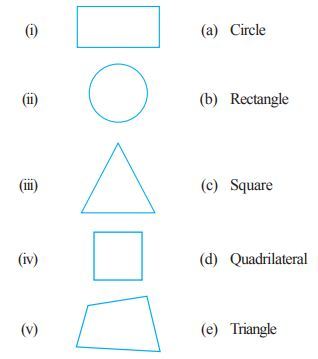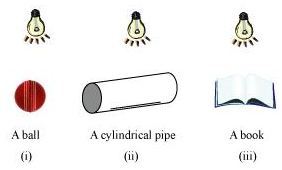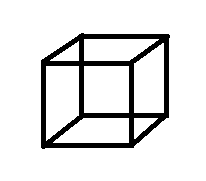7th Grade > Mathematics
VISUALISING SOLID SHAPES MCQs
:
Each part: 2 Marks
(a) Sphere, cone and cylinder are not polyhedrons.
Sphere: Sphere has only one curved face and no polygons as faces. So it is not a polyhedron.
Cone: Cone has one circular face and the remaining part is a curved surface. So it is not a polyhedron.
Cylinder: Cylinder has two circular faces and the remaining part is a curved surface. So it is not a polyhedron.
(b) (i) - (b)
(ii) - (a)
(iii) - (e)
(iv) - (c)
(v) - (d)
:
Each part: 1 Mark
(a) Edge is defined as the line segment where two faces of a polyhedron meet. A cylinder has no such line segments. Therefore, it has 0 edges.
(b) There are no vertices in a sphere as there are no sharp corners in a sphere.
(c) The figure which has all the three dimensions, viz. length, breadth and height, equal is called a cube. Therefore, the given figure is a cube.
:
Each part: 2 Marks
(a) By Euler's formula,
F + V - E = 2
Substituting the given values
10 + 15 - 20 = 35 - 20 =15 which is not equal to 2.
A solid needs to satisfy the Euler's formula to be called a polyhedron.
⇒ A polyhedron cannot have 10 faces, 20 edges and 15 vertices.
(b) The shapes of the shadows of these figures will be as follows.
(i) A ball
The shape of the shadow of a ball will be a circle.
(ii) A cylindrical pipe
The shape of the shadow of a circular pipe will be a rectangle.
(iii) A book
The shape of the shadow of a book will be a rectangle.

:
Number of faces (F) = 4
Number of edges (E) = 6
Number of vertices (V) = 4
Hence, F + E + V = 14.

:
Number of faces (F) = 9
Number of edges (E) = 16
Number of vertices (V) = 9
Hence, F + E + V = 34.

:
Number of faces (F) = 6
Number of edges (E) = 12
Number of vertices (V) = 8
Hence, F + E + V = 26
































